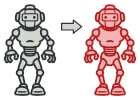
Prototype en TypeScript
Le Prototype est un patron de conception de création qui permet de cloner des objets - même complexes - sans se coupler à leur classe.
Toutes les classes prototype devraient avoir une interface commune rendant possible la copie des objets, même sans connaître leur classe concrète. Les objets prototype peuvent créer des copies complètes puisqu’ils peuvent accéder aux attributs privés des autres objets de la même classe.
Utilisation du patron de conception en TypeScript
Complexité :
Popularité :
Exemples d’utilisation : Le prototype est prêt à l’emploi dans TypeScript avec une interface Cloneable.
Identification : Le prototype peut facilement être reconnu grâce aux méthodes clone ou copier, etc.
Exemple conceptuel
Dans cet exemple, nous allons voir la structure du Prototype et répondre aux questions suivantes :
- Que contiennent les classes ?
- Quels rôles jouent-elles ?
- Comment les éléments du patron sont-ils reliés ?
index.ts: Exemple conceptuel
/**
* The example class that has cloning ability. We'll see how the values of field
* with different types will be cloned.
*/
class Prototype {
public primitive: any;
public component: object;
public circularReference: ComponentWithBackReference;
public clone(): this {
const clone = Object.create(this);
clone.component = Object.create(this.component);
// Cloning an object that has a nested object with backreference
// requires special treatment. After the cloning is completed, the
// nested object should point to the cloned object, instead of the
// original object. Spread operator can be handy for this case.
clone.circularReference = {
...this.circularReference,
prototype: { ...this },
};
return clone;
}
}
class ComponentWithBackReference {
public prototype;
constructor(prototype: Prototype) {
this.prototype = prototype;
}
}
/**
* The client code.
*/
function clientCode() {
const p1 = new Prototype();
p1.primitive = 245;
p1.component = new Date();
p1.circularReference = new ComponentWithBackReference(p1);
const p2 = p1.clone();
if (p1.primitive === p2.primitive) {
console.log('Primitive field values have been carried over to a clone. Yay!');
} else {
console.log('Primitive field values have not been copied. Booo!');
}
if (p1.component === p2.component) {
console.log('Simple component has not been cloned. Booo!');
} else {
console.log('Simple component has been cloned. Yay!');
}
if (p1.circularReference === p2.circularReference) {
console.log('Component with back reference has not been cloned. Booo!');
} else {
console.log('Component with back reference has been cloned. Yay!');
}
if (p1.circularReference.prototype === p2.circularReference.prototype) {
console.log('Component with back reference is linked to original object. Booo!');
} else {
console.log('Component with back reference is linked to the clone. Yay!');
}
}
clientCode();
Output.txt: Résultat de l’exécution
Primitive field values have been carried over to a clone. Yay!
Simple component has been cloned. Yay!
Component with back reference has been cloned. Yay!
Component with back reference is linked to the clone. Yay!